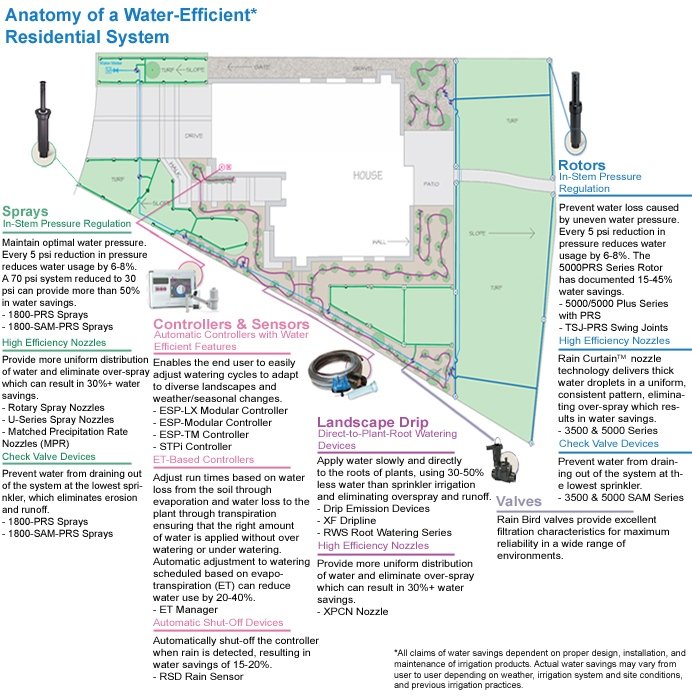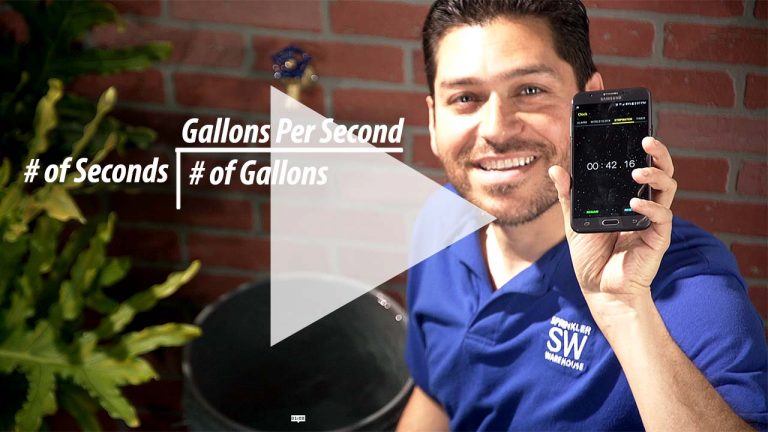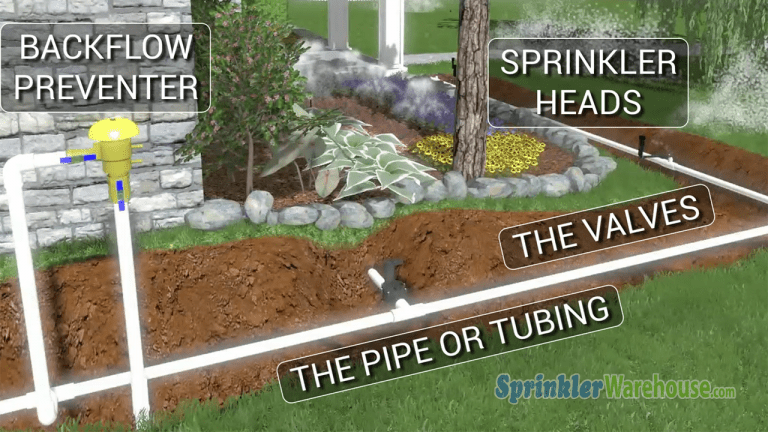Design Guide For Water-Efficient Sprinkler Systems
This design guide highlights water-efficient residential systems. These Rain Bird products are technological solutions for a healthy landscape. Some of the benefits of this irrigation system include lower bills, shorter run times and the ability to use less fertilizer and pesticides. It also creates healthier plant material, less disease, pant loss, and water waste. It even makes the site easier to maintain.

Anatomy of a Water-Efficient Residential System:
Sprays
- In-Stem Pressure Regulation– This helps to maintain optimal water pressure. For instance, every 5 psi reduction in pressure reduces water usage by 6-8%. At 70 psi system reduced to 30 psi can provide more then 50% in water savings. (Some examples of these sprays are the 1800-PRS Sprays and the 1800-SAM Sprays)
- High Efficiency Nozzles- These sprays provide more uniform distribution of water and therefore eliminate over-spray which can result in 30%+ water savings. Some examples include Rotary spray nozzles, U-Series Spray Nozzles and matched precipitation rate nozzles (MPR)
- Check Valve Devices– These devices prevent water from draining out of the system at the lowest sprinkler therefore, eliminating erosion and runoff. (An example are the 1800-PRS Sprays and the1800-SAM-PRS Sprays)
Controllers & Sensors: Residential Systems
- Automatic Controllers with Water Efficient Features: This enables the end user to easily adjust watering cycles to adapt to diverse landscapes and also to weather and seasonal changes. (An example of items that do this are the ESP-LX Modular Controller. ESP-Modular Controller. ESP-TM Controller. Another example is the STPi Controller)
- ET-Based Controllers: Adjust run times based on water loss from the soil through evaporation and water loss to the plant. This is done through transpiration ensuring that the right amount of water is applied without over watering. For instance, automatic adjustment to watering scheduled based on evapo-transpiration (ET) can reduce water use by 20-40%. (ET Manager)
- Automatic Shut-Off Devices: This automatically shuts off the controller when rain is detected. Resulting in water savings of 15-20% (RSD Rain Sensor is an example of an automatic shut-off device)
Landscape Drip: Residential Systems
- Direct-to-plant-root Watering Devices: Direct water devices apply water slowly and directly to the roots of plants. For instance, it uses 30-50% less water than sprinkler irrigation and eliminating over spray and runoff. (Some examples include the drip emission devices, the XF drip line and the RWS root watering series)
- High Efficiency Nozzles
Rotors: Residential Systems
- In stem pressure regulation: prevent water loss caused by uneven water pressure. For example, every 5 psi reduction in pressure reduces water usage by 6-8%. The 5000 PRS Series Rotor has documented 15-45% water savings. Another example is the 5000/5000 Plus series with PRS and the TSJ-PRS Swing Joints
- High efficiency nozzles: Rain Curtain nozzle technology delivers thick water droplets in a uniform, consistent pattern. Therefore it eliminates over-spray which results in water savings. (3500 & 5000 Series)
- Check valve devices: This prevents water from draining out of the system at the lowest sprinkler. The 3500 & 5000 SAM Series are examples of a rotor with these check valves. For instance, the 3500 Series Rotor is an easy to use short to mid-range 1/2″ gear-drive rotor, offering value and convenience for residential applications. Utilizing a simple flat-bladed screwdriver, the 3500’s arc adjustment is quick and easy.
Valve: Residential Systems
- Rain bird valves provide excellent filtration characteristics for maximum reliability in a wide range of environments.
However, all claims of water savings dependent on proper design, installation and maintenance of irrigation products. Actual water savings may vary from user to user depending on the circumstances. These include weather, irrigation system and site conditions, and previous irrigation practices.



























